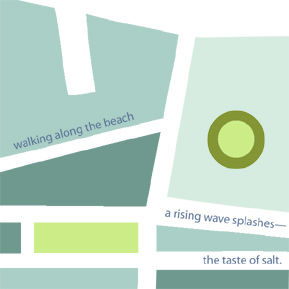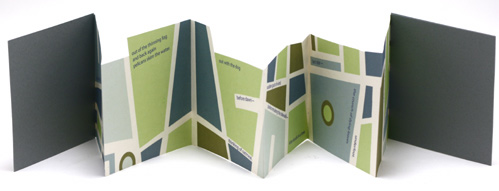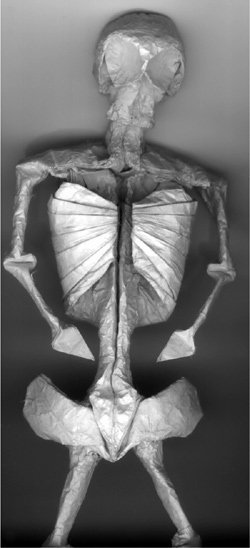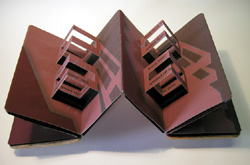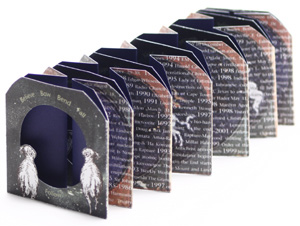 Several years ago my friend Debbie gave me a copy of Tara Bryan’s tunnel book, World Without End (that’s it to the right). A tunnel or peephole book is a set of pages bound into accordions on two sides and viewed through a central opening. Scenery or shapes are cut out of the pages and then assembled in layers. Inspired by theatrical stage sets, this book form dates from the mid-eighteenth century and continues to be popular. I immediately deconstructed Tara’s book to figure out how she made it (very ingeniously with a single sheet of paper) and then wrote up instructions for a class I was teaching at SFCB.
Several years ago my friend Debbie gave me a copy of Tara Bryan’s tunnel book, World Without End (that’s it to the right). A tunnel or peephole book is a set of pages bound into accordions on two sides and viewed through a central opening. Scenery or shapes are cut out of the pages and then assembled in layers. Inspired by theatrical stage sets, this book form dates from the mid-eighteenth century and continues to be popular. I immediately deconstructed Tara’s book to figure out how she made it (very ingeniously with a single sheet of paper) and then wrote up instructions for a class I was teaching at SFCB.
 For the Fall 2008 Ampersand, Debbie wrote a profile of Tara, and I thought I’d include those instructions in the issue as well. Then John Sullivan, who is the new president of PCBA (the member organization that publishes Ampersand), cut and scored sheets with a blank tunnel book on it, so members could easily make their own. You can buy a copy of the Fall Ampersand here.
For the Fall 2008 Ampersand, Debbie wrote a profile of Tara, and I thought I’d include those instructions in the issue as well. Then John Sullivan, who is the new president of PCBA (the member organization that publishes Ampersand), cut and scored sheets with a blank tunnel book on it, so members could easily make their own. You can buy a copy of the Fall Ampersand here.
 Ed Hutchins’ article Exploring Tunnel Books includes a history of tunnel books and a photo gallery of example books. There are good discussions of what makes the structure a book, rather than a novelty piece, how various artists have adapted the form, and how one might incorporate text.
Ed Hutchins’ article Exploring Tunnel Books includes a history of tunnel books and a photo gallery of example books. There are good discussions of what makes the structure a book, rather than a novelty piece, how various artists have adapted the form, and how one might incorporate text.
 Book artist and teacher Carol Barton has been instrumental in popularizing tunnel books with book artists. You can see some of her early work, along with several other artists’ examples.
Book artist and teacher Carol Barton has been instrumental in popularizing tunnel books with book artists. You can see some of her early work, along with several other artists’ examples.
 Maria Pisano’s The Four Elements Series are elegant miniature tunnel books (scroll down on the page to see them). There are good pictures of each book, allowing you to see inside as well as how she made the covers. There’s another tunnel book on that page too, called Tunnel Vision.
Maria Pisano’s The Four Elements Series are elegant miniature tunnel books (scroll down on the page to see them). There are good pictures of each book, allowing you to see inside as well as how she made the covers. There’s another tunnel book on that page too, called Tunnel Vision.
 Peter & Donna Thomas have made a tunnel book inside a ukulele. They have more traditional tunnel books pictured here and here.
Peter & Donna Thomas have made a tunnel book inside a ukulele. They have more traditional tunnel books pictured here and here.
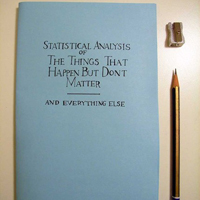 My Reader’s Diary was mentioned recently in a blog article by Sarah Nicholls of the Center for Book Arts in NYC. Top 10 Books, Zines & Comics is a good introduction to what’s on offer on Etsy. She lists 10 categories (zines, comics, diaries, journals, albums, letterpress books….) with an example of each and then a link to search for more. Check it out here. The one to the left is the zine “Stastictical Analysis of The Things That Happen But Don’t Matter” from Sarah McNeil.
My Reader’s Diary was mentioned recently in a blog article by Sarah Nicholls of the Center for Book Arts in NYC. Top 10 Books, Zines & Comics is a good introduction to what’s on offer on Etsy. She lists 10 categories (zines, comics, diaries, journals, albums, letterpress books….) with an example of each and then a link to search for more. Check it out here. The one to the left is the zine “Stastictical Analysis of The Things That Happen But Don’t Matter” from Sarah McNeil.

